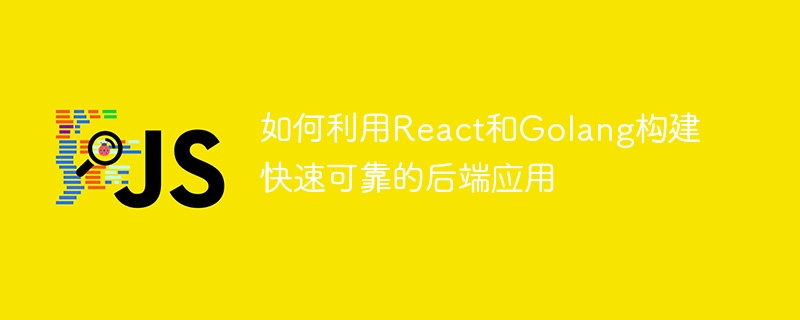Home >Web Front-end >JS Tutorial >How to build fast and reliable backend applications with React and Golang
How to build fast and reliable backend applications with React and Golang
- WBOYWBOYWBOYWBOYWBOYWBOYWBOYWBOYWBOYWBOYWBOYWBOYWBOriginal
- 2023-09-27 13:09:311699browse

How to use React and Golang to build fast and reliable back-end applications
Introduction: React and Golang are one of the most popular front-end and back-end development technologies today. This article will teach you how to use React and Golang to build fast and reliable backend applications, while providing specific code examples.
1. Introduction to React
React is a JavaScript library developed by Facebook for building user interfaces. It uses componentization to split the user interface into independent reusable parts to quickly build an efficient user interface. The core idea of React is virtual DOM (Virtual DOM), which uses JavaScript objects to represent elements in the DOM. By comparing changes in the virtual DOM, it minimizes operations on the actual DOM and improves application performance.
2. Introduction to Golang
Golang is a programming language developed by Google. It has the characteristics of high efficiency, cross-platform, and concurrency security. Golang is designed to be simple and efficient. It provides a wealth of libraries and tools suitable for building high-performance server-side applications. Golang's concurrency model is based on goroutine and message passing mechanisms, allowing developers to easily write concurrency-safe code.
3. Advantages of using React and Golang together
- Two-way data binding: React uses virtual DOM and two-way data binding mechanism to make the connection between front-end page and back-end data The interaction between them is more efficient and flexible.
- Efficient rendering performance: React uses virtual DOM to update the actual DOM, which improves the rendering performance of the application by minimizing DOM operations.
- Powerful component-based development capabilities: React’s component-based development model enables each component of the front-end application to be independently developed, tested, and reused, greatly improving development efficiency.
- Concurrency safety: Golang’s concurrency model is based on coroutines and message passing, making it easy to write concurrency-safe backend code.
4. Specific implementation of the combination of React and Golang
-
Create a React application: First, we use the create-react-app command to create a React application. Run the following command in the command line:
npx create-react-app my-app cd my-app npm start
-
Create a Golang backend: Create a new main.go file and write the following code:
package main import ( "encoding/json" "log" "net/http" ) type Message struct { Text string `json:"text"` } func main() { http.HandleFunc("/api/message", func(w http.ResponseWriter, r *http.Request) { message := Message{"Hello, World!"} w.Header().Set("Content-Type", "application/json") json.NewEncoder(w).Encode(message) }) log.Fatal(http.ListenAndServe(":8080", nil)) } -
Connect the front-end and back-end: In React's App.js file, write the following code to communicate with the back-end through the fetch function and display the returned message:
import React, { useEffect, useState } from 'react'; function App() { const [message, setMessage] = useState(''); useEffect(() => { fetch('/api/message') .then(response => response.json()) .then(data => setMessage(data.text)); }, []); return ( <div> <h1>{message}</h1> </div> ); } export default App; -
Run the application: In the command Run the following command in the line to start the front-end application:
npm start
Run the following command in another command line window to start the back-end application:
go run main.go
Now, visit http://localhost in the browser: 3000, you will see the message returned by the backend displayed on the page.
5. Summary
This article introduces how to use React and Golang to build fast and reliable back-end applications, and gives specific code examples. The combined use of React and Golang can not only improve the rendering performance and development efficiency of the application, but also ensure the concurrency safety of the back-end application. I hope this article can help you better understand and apply React and Golang.
The above is the detailed content of How to build fast and reliable backend applications with React and Golang. For more information, please follow other related articles on the PHP Chinese website!

